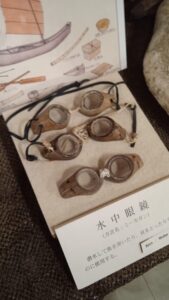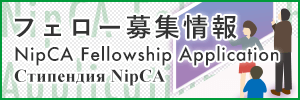The first destination of our field trio was the “Ishigaki City Yaeyama Museum” where we had a throughout lecture about the island’s history and culture. The structure of the museum was constructed on the former Ishigaki City Hall site as a commemorative project for the return to the mainland, and it officially opened its doors in October 1972. The museum houses an extensive collection showcasing the local crafts of Ishigaki and the surrounding islands in the Yaeyama chain. With over 5,000 exhibits, the collection encompasses a variety of items, including traditional boats and canoes representative of the Yaeyama chain. Additionally, the museum features Shiisa masks from Okinawan festivals and local textiles, particularly clothing.
Visitors can explore scale models of traditional Yaeyama architecture, gaining insight into the region’s distinctive structural designs. The museum also displays coffin palanquins, offering a glimpse into historical funeral practices, as well as scrolls and other documents that provide a deeper understanding of the area’s rich history. Overall, the exhibits offer a comprehensive view of the cultural and historical heritage of Ishigaki and the surrounding Yaeyama islands.
As for the the Yaeyama Islands chains, they include Ishigaki, Taketomi, Kohama, Kuroshima, Hatoma, Aragusuku (Panari), Iriomote, Yubu, and Yonaguni islands. They lie at the very southern end of the Japanese archipelago, about 400 kilometers from Okinawa’s main island. They are collectively regarded for their natural beauty, which includes gorgeous beaches and lush vegetation, as well as superb diving. The entire area has been designated a national park (Iriomote-Ishigaki National Park) to preserve it for future generations.
Lecture started with the overview of the island and people’s history. Approximately 27,000 years ago, there were discovered human bones but no accompanying tools, leaving researchers unable to discern the specific lifestyle of the inhabitants. It is said that Yaeyama people developed their own distinct culture, distinct from both Okinawa and Japan, characterized by a more tropical style. For instance, even tough there were some commonalities observed with the Ainu people in Okinawa mainland, this connection was not found in Yaeyama. Yaeyama people also developed their own distinct language system that is different from Okinawa main island and the Miyako Islands, called the Yaeyama dialect. The Yaeyama dialect does not refer to just one dialect. Instead, each island, and even each village within the region, may have its own dialect. The number of people who can speak in dialect has become few, and there is now an effort to pass this on to future generations through study sessions, etc.
Shimotabaru Culture
The first ethnic groups emerged in these islands in the area known as Shimotabaru and were discovered thanks to their pottery art. The gently shaped, round-bottomed pottery is called “Shimotawara-style pottery,” and is the oldest pottery on Sakishima Island, and is said to be the original form of pottery in Miyako and Yaeyama . These sites are found on a red volcanic soil. After the short lived Shimotabaru phase, the next occupation is argued to have been some 800 years later. Shimotabaru people eventually disappeared, giving way to Mudoki people.
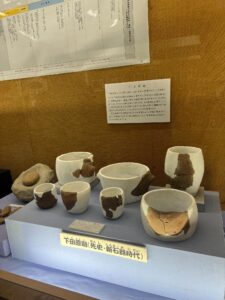

Subsequently, the Mudoki people emerged, lacking pottery art but claiming a history spanning thousands of years. Their culture involved the use of stone and seashells, with unique practices like cooking on hot stones for steaming food as they didn’t use any pots. They also had developed agriculture and harvesting skills which eventually lead to the increase of the population. However, this indigenous culture declined due to Japanese influence. Interestingly, the Japanese brought iron with them, introducing iron pots that proved beneficial for cooking. 。
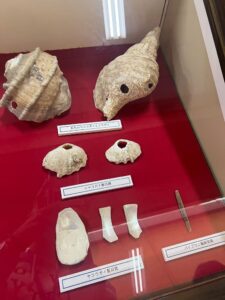
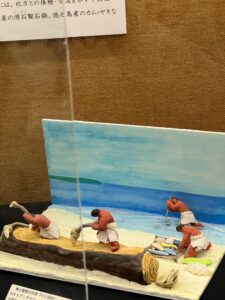
Evidence of cultural exchange was found in pottery from China and the mainland, indicating a blending of cultures around 500 years ago. The region experienced conflicts, such as disputes between Ishigaki Island families who were divided on whether to align with Ryukyu Kingdom or Ishigaki. Ultimately, the Ishigaki island became part of Ryukyu. However, the region didn’t lose ties with other islands, as artefacts, including bowls discovered underwater, suggested possible trade with other regions, especially China.
About 300 years ago, a conflict arose between Ryukyu kingdom and Kagoshima, a region in Kyushu, resulting in the incorporation of the entire kingdom into Kagoshima, becoming a part of Japan. Japanese people upon arrival to islands, noticed the absence of a temple and directed the Ryukyu king to build one, also instructing islands to adopt Japanese culture. So, the first temple was built in 1609 in Ishigaki, being originated from Japan.
There are different cultural features of Yaeyama islands, one of them being an origins of “Satsumaimo”, a sweet potato. Across Japan, it is commonly associated with Kagoshima, but was actually introduced by Satsuma people in Yaeyama.
Coming to rich folklore and music culture, there are folk songs sung only with the human voice and no accompaniment, called “koyou”, or old songs, and songs accompanied by the Sanshin or flute, called “fushiuta”. The Sanshin itself is a distinct instrument with three strings and is made by snake skin. Usually it accompanies fushiuta and was brought to Yaeyama by officials of the Ryukyu Kingdom. Many fushiuta songs were created through the spread of the Sanshin. Dances choreographed to koyou and fushiuta songs are mostly dedicated as part of ritual ceremonies, and are often danced during celebrations and as part of large performances.
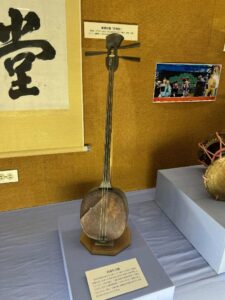
Museum also had “Hatagashira” – flag banner made for celebration with each village having their own. They are usually used during celebration of “Obon” festival during mid-late August.
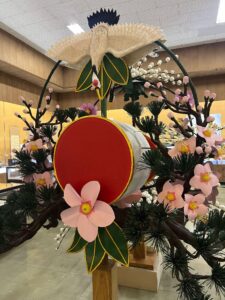
Lastly, there were artefacts from “Itoman” culture, Okinawa village known for its fishery. Fishers from this village are believed to reach even Australia. The underwater googles made around 200 years ago strongly resemblance the modern days googles which speaks about the high skills and knowledge of Itoman people.
